Jeremy Bamber: ‘New evidence proves unfair trial’
Exclusive: Jeremy Bamber, who was sentenced to life in 1986 for the murder of five of his family members, has claimed that previously-unseen police photographs prove he was not given a fair trial.
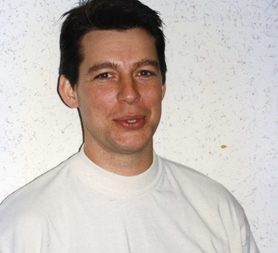
Bamber, 50, has always protested his innocence, claiming that his sister Sheila, who had paranoid schizophrenia, used a rifle to kill her adoptive parents, Nevill and June, and her six-year-old twin sons, Daniel and Nicholas, before shooting herself in the remote Essex farmhouse. The Bamber murder case is one of the most notorious criminal cases in modern British history. Bamber’s legal team plan to set out a series of apparent inconsistencies in the case presented to the original trial court:
• Photographs which his lawyers allege show that the gun was moved
• One police officer described having no memory of the gun being at the crime scene
• Inconsistencies in the blood-spatter evidence
• X-rays revealing bullets which were presented whole at trial had broken up on impact
Bamber’s legal team claim that photos of Sheila, known as Bambi – which show the murder weapon, a rifle, positioned in different places on her body – point to evidence-tampering and are therefore incompatible with the prosecution’s case. They add that the inconsistencies the photographs depict appear to be supported by the records of police officers who attended the scene of the crime. One detective raised concerns after seeing the pictures, describing having no recollection of seeing the rifle at all when he was at the scene.
The White House Farm murders
The White House Farm murders became among the most infamous multiple murders of a generation, because they bore all the hallmarks of a detective crime novel: a brutal massacre behind locked doors, a mentally-unstable model with a fanatical religious streak, a suave and conniving son, and his jilted lover who informed on him to police a month later. When police arrived at the scene, they thought the killings pointed to a murder/suicide, but three days later, one of Bamber’s cousins found a silencer in a box in the gun cupboard and presented it to police.
The silencer had a speck of blood on it, which a scientist concluded had come from Sheila, although doubts have since been raised about the authenticity of the tests. Police claimed that it would not have been possible for Sheila to shoot herself and then return the silencer to the cupboard.
About a month after the murders, Bamber broke up with his girlfriend, Julie Mugford, after she discovered that he had had sex with her best friend.
Miss Mugford went to police the next day and told officers that Jeremy had been planning the murders for some time and called her on the night of the killings, saying: “Tonight’s the night.”
The trial
At Bamber’s trial – at Chelmsford Crown Court in October 1986 – he was convicted on a 10-2 majority verdict. The jury was asked to decide whether he had murdered his family to inherit an estate worth around £500,000 (£1m in today’s money) or whether schizophrenic Sheila Caffell carried out the massacre after her parents suggested that her children should be taken into foster care.
The jury decided Sheila could not have killed her family before turning the gun on herself, and that it was Bamber who committed the crimes and re-staged the scene to appear like a murder/suicide.
But Channel 4 News has seen for the first time a series of police pictures showing a .22 Anschutz semi-automatic rifle, the murder weapon, seemingly resting in different positions on Sheila’s body and also placed around the bedroom where she was found dead. Bamber’s legal team argue that because the trial jury convicted him on grounds that he had re-staged the crime scene, these photos prove he was not given a fair trial.
They claim that, at the least, the pictures cast doubt on part of the prosecution case and appear to expose significant inconsistencies in the evidence from 7 August 1985.
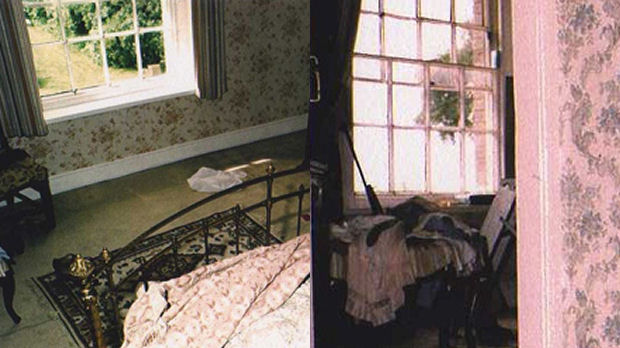
The rifle rests above and below Sheila’s neckline in different close-up images. In wide shots of the room, the gun appears propped up against a window and is then missing in another. Essex police officers told the trial jury that the gun on her body was not moved in the aftermath of the crime and only made safe at 11.10am.
But Bamber’s defence team argues that all of the police pictures photographed in the room were taken at least 50 minutes before then. A blown-up image of one of the pictures of the master bedroom of the farmhouse, in which the bodies of June and Sheila were found, shows a clock on the bedside table reading 10.20am, indicating that the gun could have been moved during the photographing sessions: almost an hour before police testified it had been.
‘No recollection of gun’
Various logs of different police officers at the scene suggest incongruous accounts of the positioning of Sheila’s body and also where the gun lay in relation to her. One police officer raised concerns that, after viewing the photos, Sheila’s body was in a different position from when he saw her, before 8.45am.
“Photo of Sheila not in same position as when I saw it,” his notes reads. “Head too close to bedside table. Not sure about angle of head but something not right. No recollection of gun. Was level with her waist 12-18in away.”
Another officer, on first inspecting the room at 9.30am, half an hour before the photographer arrived in the room, noted: “Daughter with .22 rifle by her right side.”
Dr Herbert Leon MacDonell, director of the New-York based Laboratory for Forensic Science, studied the photographs for the defence team and concluded that the pattern of blood spatter suggested movement of the body.
Dr MacDonell, who testified in the OJ Simpson murder case and was involved in the investigations into the assassinations of US Senator Robert F Kennedy and Martin Luther King Jr, told Channel 4 News: “From the bloodstain patterns the victim’s arms must have been moved.
“Bloodstains on the floor showed that other objects were also moved. I concluded that it had to have been murder because of the two shots under her chin. (But) Some time later I learned that the pathologists concluded that she could have fired both shots so I now believe it could have been suicide as well.”
Peter Sutherst, a photographic expert, adviser to crime scene officers, and on the UK register of expert witnesses, examined around 400 of the previously-undisclosed negatives.
He told Channel 4 News: “Based on knowledge of how roll films are put together with frame numbers in sequence, the pictures of Sheila with the rifle on her were taken early on in the photographing process.
“(The officer) started in the kitchen first, then to the bedroom Sheila was found in and then to several other rooms afterwards.
“I think those pictures were taken between 10.20 and 10.45. It is extremely unlikely they were taken after that.”
Mr Sutherst added that scores of negatives from the film roll remained undisclosed.
Hurd: ‘Errors were made’
In 1989, the then Home Secretary Douglas Hurd ordered a tightening of procedures for police investigations following the murders. He said that the operation had been riddled with errors.
“First, the senior investigating officer (DCI ‘Taff’ Jones), having assessed the scene of the crime and considered the information provided by Jeremy Bamber, wrongly concluded that Sheila Caffell had taken her own life and shooting her parents and twin sons,” he said.
“In consequence of this error of judgement, he did not follow normal procedures of potential murder cases, and was reluctant to take account of information which challenged his original assessment.
“Secondly, there was inadequate supervision of the senior investigating officer to ensure that existing force practices were observed and that the inquiries took account of the information coming to light.”
Catalogue of new evidence
The discovery of the photographs is the latest in a catalogue of around 100,000 pages Bamber has accessed from his prison cell in Full Sutton, Yorkshire, via the Freedom of Information Act and the Data Protection Act.
He and his legal team – headed by lawyer Barry Woods – have also uncovered the following evidence which they hope could overturn his conviction:
• The pictures of Sheila’s body also show wet blood flowing from Sheila’s wounds, according to the defence. Bamber’s team say that experts have told them that because the blood had not coagulated at the time of photographing at 10.30am, she could have been killed no earlier than 7am. Bamber had been with police officers since about 3am.
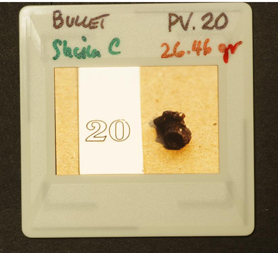
• An X-Ray of Sheila’s neck, which shows one bullet fragmented into 14 pieces and a second bullet intact in her brain. However, police showed the court two unbroken bullets at the trial.
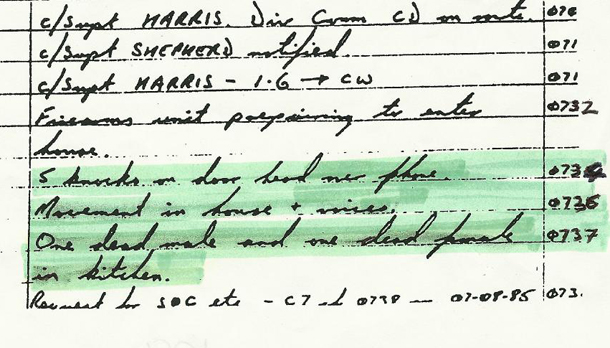
• Police logs showing some of the officers who first arrived at the farmhouse reporting that there were two bodies, a male and a female, dead in the kitchen, while they were in the presence of Bamber. The final report stated that only the male body – that of Bamber’s father Nevill – was found in the kitchen, with the other bodies in four upstairs rooms. Bamber’s supporters argue that the female body was Sheila’s, and she had gone upstairs to kill herself between the time of the log entry and some time after police entered the house, several hours later.
• Another police log in which an officer reports that officers were in conversation with someone inside the farmhouse upon their arrival.
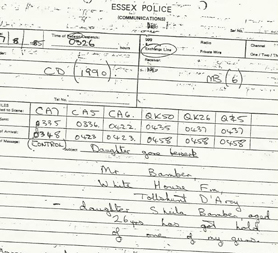
• Two “lost” police logs, which Bamber’s defence team claim show that Nevill called police at 3.26am saying his daughter had “gone berserk” and “got hold of one of my guns”. The record is almost identical to another phone log timed at 3.36am in which Bamber made from his home in Goldhanger, three-and-a-half miles away from the farm.
• Mr Sutherst has also found that scratch marks the prosecution said had been caused by Bamber – in a tussle between him and his father – on the night of the killings might have actually been made a month later. After scrutinising photographs taken on the day of the murders, he found no indication of the scratch marks, said to have been made by the silencer. Mr Sutherst then found that the photograph of the scratches used in Bamber’s trial was taken on 10 September, over a month after the murders.
Forensic officers established that Sheila could not have shot herself and return the silencer to the cupboard.Mr Sutherst told Channel 4 News: “There is no doubt that marks made by the silencer, which were visible a month later, were not present on the day of the killings. In the photos taken on the day of the crimes, I could see no scratches and no residue of paint which invariably would have been there if scratches were made.”
Awaiting CCRC verdict
Bamber submitted his findings to the Criminal Cases Reviews Commission (CCRC) last year and is awaiting a decision that has been set for 31 January to see whether his case will be referred to the Court of Appeal. The CCRC would only make a referral if it determines that there is a “real possibility” the conviction will not be upheld. This means it must second-guess what the appeal courts may make of a referral.
Its governing statute is: “(The CCRC) do not consider innocence or guilt, but whether there is new evidence or argument that may cast doubt on the safety of an original decision.”
Bamber has previously had two appeals quashed, in 1989 and 2002.
At the last hearing, Lord Justice Kay told the court: “We have concluded that there was no conduct on the part of the police or the prosecution which would have adversely affected the jury’s verdict.”
However, none of the new evidence was available to Bamber then: his legal team were handed the photographs of Sheila’s body in only 2004.
Bamber was sentenced to serve no less than 25 years at the 1986 trial, but in 1992, the then Home Secretary Michael Howard changed the sentence to a whole life tariff.
He lost an appeal against the decision in 2009 and is currently awaiting a verdict on an appeal against the life-meaning-life tariff from the European Court of Human Rights.
Bamber’s legal team say that if the CCRC refers Bamber’s case and appeal judges are convinced by the new documents, photographs and experts’ analysis, their client, who has been in jail for 25 years, could have suffered one of the greatest miscarriages in the history of the British legal system.
-
Latest news
-
Mark Menzies: is UK politics full of scandal?33m

-
Windrush scandal: returning to the UK after a forty year wait6m

-
Netanyahu ‘survival’ depends on ‘expanding war’ says head of Palestinian National Initiative5m

-
Proposed law change could strip parental rights from paedophiles5m

-
Hugh Grant settles privacy lawsuit against The Sun newspaper publisher2m

-




